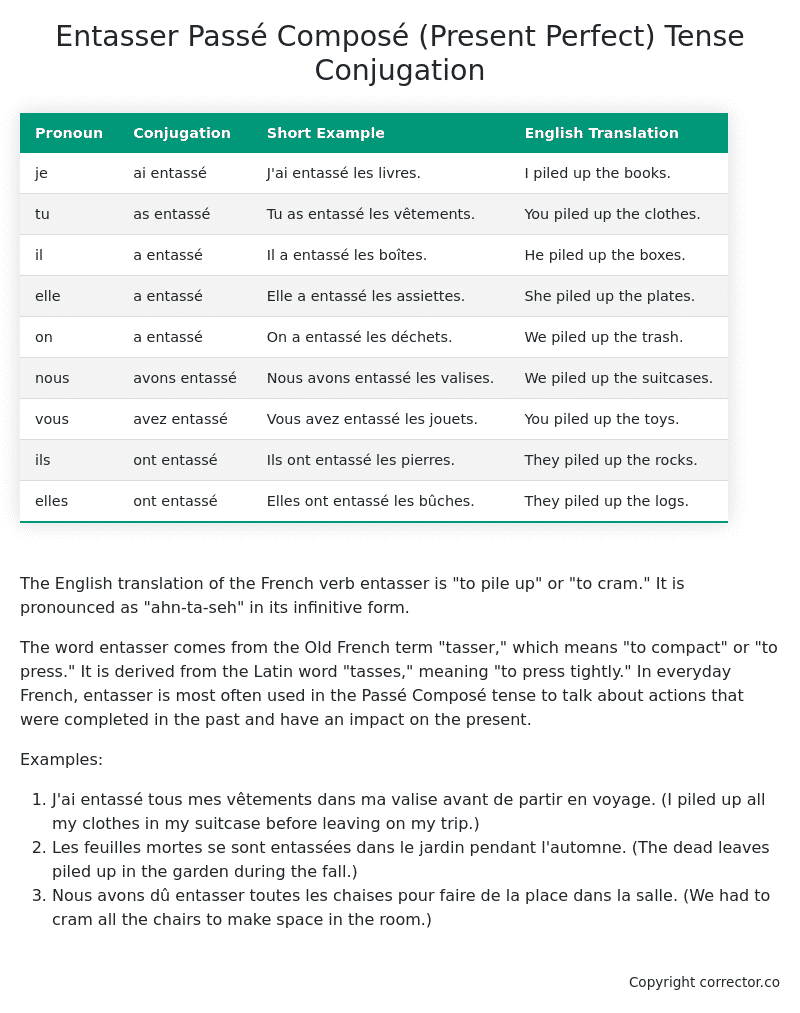Passé Composé (Present Perfect) Tense Conjugation of the French Verb entasser
Introduction to the verb entasser
The English translation of the French verb entasser is “to pile up” or “to cram.” It is pronounced as “ahn-ta-seh” in its infinitive form.
The word entasser comes from the Old French term “tasser,” which means “to compact” or “to press.” It is derived from the Latin word “tasses,” meaning “to press tightly.” In everyday French, entasser is most often used in the Passé Composé tense to talk about actions that were completed in the past and have an impact on the present.
Examples:
- J’ai entassé tous mes vêtements dans ma valise avant de partir en voyage. (I piled up all my clothes in my suitcase before leaving on my trip.)
- Les feuilles mortes se sont entassées dans le jardin pendant l’automne. (The dead leaves piled up in the garden during the fall.)
- Nous avons dû entasser toutes les chaises pour faire de la place dans la salle. (We had to cram all the chairs to make space in the room.)
Table of the Passé Composé (Present Perfect) Tense Conjugation of entasser
| Pronoun | Conjugation | Short Example | English Translation |
|---|---|---|---|
| je | ai entassé | J’ai entassé les livres. | I piled up the books. |
| tu | as entassé | Tu as entassé les vêtements. | You piled up the clothes. |
| il | a entassé | Il a entassé les boîtes. | He piled up the boxes. |
| elle | a entassé | Elle a entassé les assiettes. | She piled up the plates. |
| on | a entassé | On a entassé les déchets. | We piled up the trash. |
| nous | avons entassé | Nous avons entassé les valises. | We piled up the suitcases. |
| vous | avez entassé | Vous avez entassé les jouets. | You piled up the toys. |
| ils | ont entassé | Ils ont entassé les pierres. | They piled up the rocks. |
| elles | ont entassé | Elles ont entassé les bûches. | They piled up the logs. |
Other Conjugations for Entasser.
Le Present (Present Tense) Conjugation of the French Verb entasser
Imparfait (Imperfect) Tense Conjugation of the French Verb entasser
Passé Simple (Simple Past) Tense Conjugation of the French Verb entasser
Passé Composé (Present Perfect) Tense Conjugation of the French Verb entasser (this article)
Futur Simple (Simple Future) Tense Conjugation of the French Verb entasser
Futur Proche (Near Future) Tense Conjugation of the French Verb entasser
Plus-que-parfait (Pluperfect) Tense Conjugation of the French Verb entasser
Passé Antérieur (Past Anterior) Tense Conjugation of the French Verb entasser
Futur Antérieur (Future Anterior) Tense Conjugation of the French Verb entasser
Subjonctif Présent (Subjunctive Present) Tense Conjugation of the French Verb entasser
Subjonctif Passé (Subjunctive Past) Tense Conjugation of the French Verb entasser
Subjonctif Imparfait (Subjunctive Imperfect) Tense Conjugation of the French Verb entasser
Subjonctif Plus-que-parfait (Subjunctive Pluperfect) Tense Conjugation of the French Verb entasser
Conditionnel Présent (Conditional Present) Tense Conjugation of the French Verb entasser
Conditionnel Passé (Conditional Past) Tense Conjugation of the French Verb entasser
L’impératif Présent (Imperative Present) Tense Conjugation of the French Verb entasser
L’infinitif Présent (Infinitive Present) Tense Conjugation of the French Verb entasser
Struggling with French verbs or the language in general? Why not use our free French Grammar Checker – no registration required!
Get a FREE Download Study Sheet of this Conjugation 🔥
Simply right click the image below, click “save image” and get your free reference for the entasser present perfect tense conjugation!

Entasser – About the French Passé Composé (Present Perfect) Tense
Formation of the Passé Composé
Set the auxiliary verb with either
Conjugate the auxiliary verb
Add the past participle
Common everyday usage patterns
Narrating Past Events
Sequential Actions
Describing Completed Actions
Interactions with other tenses
Imperfect Tense
Conditional and Future Tenses
Summary
I hope you enjoyed this article on the verb entasser. Still in a learning mood? Check out another TOTALLY random French verb conjugation!


